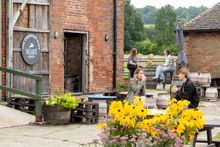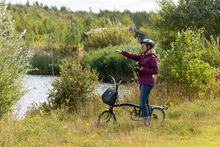 16 May 2025
16 May 2025
The National Forest has been named as a national example of how tourism can be a force for good, in a new VisitEngland report exploring the social value of tourism across the UK.
Published this month, the report finds that tourism strengthens community pride, improves wellbeing, and enhances everyday life in places that welcome visitors. It shows that host communities enjoy better access to green spaces, cultural amenities and local businesses – and feel more connected and empowered as a result.
The National Forest is highlighted as a leading case study in regenerative tourism, where visitor numbers are growing alongside environmental recovery, community benefit and long-term sustainability.
“This report confirms what we've seen locally for years – that tourism can restore landscapes and livelihoods,” said Richard Drakeley, tourism development manager at the National Forest. “It's not just about numbers, it's about purpose. People want to visit places that give something back.”
Stretching across 200 square miles in the Midlands, the Forest has planted more than 9.8 million trees and helped transform one of the country's least wooded areas into a thriving destination for walking, cycling, heritage and nature. Tourism has supported more than 5,000 jobs in the Forest and continues to grow, with new businesses, events and accommodation helping to drive year-round visits.
Visitors can follow the woodland sculpture trail at Moira Furnace, where ironworking heritage meets creative outdoor art. They can hire bikes at Hicks Lodge, a purpose-built cycle centre with accessible trails winding through young woodland and open heathland. Nearby, Conkers offers family-friendly woodland walks, treetop adventures, and a discovery centre, while Sence Valley Forest Park provides peaceful circular routes through former mining land now transformed into nature-rich forest.
Many visitors choose to stay longer, booking countryside getaways with forest views at places like Rosliston Lodge, or glamping at Charnwood Wigwams. Trips are often timed to coincide with popular events such as the annual two-week National Forest Walking Festival or Whistlewood's immersive nature experiences, from foraging workshops and traditional crafts to seasonal celebrations around the fire.
The report also shows a clear appetite for responsible travel. Almost 60 per cent of people say they try to leave places better than they found them, and two-thirds aim to support local businesses when they travel. In the National Forest, this ethos is built into planning, design and development through the Forest's sustainability guidelines and partnerships with local producers, attractions and hospitality.
“People come here to feel better – to be outdoors, slow down, and connect with nature and each other. We want them to leave knowing they've helped the Forest grow,” added Richard.
The National Forest stands as a national exemplar of what can be achieved when visionary people come together with a shared ambition for a greener, more sustainable future. Rooted in regeneration and driven by purpose, the Forest demonstrates how tourism can restore both place and pride—reviving landscapes, empowering communities and inspiring visitors to play their part. As this report shows, the National Forest is not just a destination, but a living, growing symbol of how bold ideas can shape a better future.
Ends
Notes to editors
- The Social Value of Tourism report was published by VisitEngland and Public First in May 2025.
The National Forest covers 200 square miles of the counties of Derbyshire, Leicestershire and Staffordshire. Its creation began in the early 1990s, a radical vision to bring the benefits of trees, woodland and multi-use forestry to lowland England, where thousands of people live and work.
The Forest provides a national demonstration of the value of the natural environment to drive regeneration and showcase policy and practice, research and development in the heart of the country.
It was the first broadleaf forest to be created at scale in England for more than 900 years and is now seen as one of the boldest environmentally led regeneration initiatives in the country. It has transformed a post-industrial Midlands landscape – scarred by coal mining and heavy industry - from black to green.
Year by year, the National Forest has been steadily turning what was once one of the least wooded areas of England into a multi-purpose, sustainable forest. More than nine million trees have been planted so far. Forest cover has increased from 6% to 25%, approaching double the national average for woodland cover. The aim is to reach around a third forest cover.
Trees have been the catalyst for change and transformation. The National Forest is a positive response to the climate crisis and is putting in place the building blocks to deliver mitigation and adaptation to climate change. Through partnerships the National Forest is working to create wildlife habitats, reduce flooding, improve air quality, store carbon and create space for outdoor education, supporting the health and wellbeing of communities and enabling Forest-related businesses to thrive.
The National Forest Company (charity no: 1166563) leads the creation of the National Forest, working in partnership with landowners, local authorities, businesses and its communities. It has strong support from government, politicians and the public, and continues to be supported by the Department for Environment, Food and Rural Affairs.
Contact: Carolyn Bointon
Telephone: 07855 976367
Email: cbointon@nationalforest.org





